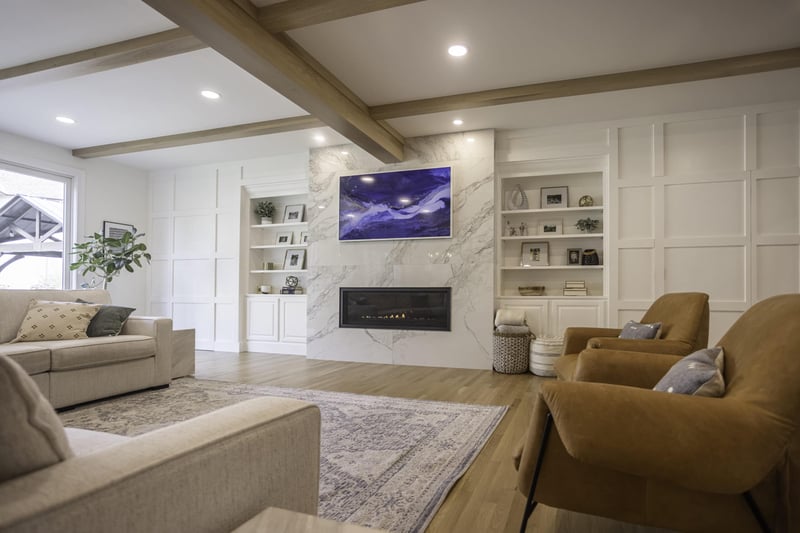7 Home Remodeling Mistakes To Avoid in Cincinnati
Remodeling your home can and should be an exciting and fulfilling experience. However, we’ve met plenty of homeowners across the Greater Cincinnati area who started their projects full of excitement, only to hit unexpected delays, mounting costs, or design choices they regretted once the dust settled. Most of these issues? Completely avoidable with the right plan and the right team.
Legacy Builders Group has been remodeling homes for generations, and we’ve learned a thing or two about what not to do. So, we’re sharing the most common home renovation mistakes and how to sidestep them for a smoother, more satisfying remodel.

Mistake #1: Rushing Into Construction Without a Solid Plan
Of course, you're excited about your renovation. Once you’ve made the decision to remodel, it’s tempting to dive in headfirst and start tearing out cabinets or picking paint colors. But here’s the thing: great design doesn’t happen overnight.
One of the most common (and costly) home renovation mistakes is skipping the planning phase or treating it like a formality. When you start construction without finalizing layouts, making selections, or carefully thinking through the full scope of work, you're setting yourself up for delays, last-minute change orders, and design regrets.
We’ve seen it happen too many times: a homeowner rushes to demo day, only to discover halfway through that the tile they wanted is backordered, or that the layout doesn’t accommodate their daily routines. That’s why we spend an average of 4+ months on the design phase at Legacy Builders Group.
During that time, we:
-
Finalize every layout detail and floor plan
-
Guide you through selections that fit your style and budget
-
Coordinate cabinetry (especially custom builds) early
-
Get ahead of any permitting or structural needs
The result? Fewer surprises. Less stress. And a smoother construction phase that stays on time and on budget.

Mistake #2: Not Setting a Realistic Renovation Budget
We know budgeting isn’t the most glamorous part of remodeling, but it’s one of the most important. A common home renovation mistake? Underestimating the true cost of the work and forgetting to plan for the what-ifs.
Even with careful planning, unexpected costs can pop up. Maybe there’s hidden water damage behind the walls. Maybe your electrical panel needs an upgrade to meet code. Whatever the case, your budget needs room to breathe.
And just as important: knowing where to invest intentionally. For some homeowners, that means splurging on custom cabinetry or statement lighting. For others, it’s about function, like soft-close drawers or extra storage.
The goal is to spend smart, so you’re thrilled with the results and confident in the investment. During the design phase, Legacy Builders Group thoroughly evaluates your home for construction contingencies and helps you tailor your choices to your priorities.
-
Prioritize your must-haves vs. nice-to-haves
-
Understand the cost impact of design choices
-
Align your budget with realistic expectations and quality standards
Mistake #3: Ignoring How You Actually Live in the Space
That Pinterest-perfect layout may look stunning, but will it work for you day-to-day? Too often, homeowners focus on aesthetics and overlook how their new space will function daily. A kitchen that looks amazing but lacks prep space or a bathroom with zero storage can quickly become a daily frustration.
We believe great design is functional first. Our design process starts with how you use your home, not just how you want it to look. Whether it’s creating a traffic flow that makes sense for cooking and conversation or making sure there’s enough pantry space to hide the snacks, we design with your real life in mind.
We’ll ask:
-
Do you entertain often?
-
How much storage do you need?
-
Do you need outlets in specific places (coffee bar, anyone)?
- Are you sharing this bathroom with kids… or guests?

Mistake #4: Changing Your Mind Too Often
It happens: You see a new backsplash on Instagram halfway through your remodel… and suddenly, the one you chose feels all wrong. However, frequent mid-project changes are one of the fastest ways to derail a timeline and blow a budget.
Every time a material is swapped, a layout is adjusted, or a new item is added to the scope, it triggers a ripple effect. Materials may need to be reordered. Trades might have to be rescheduled. You may be charged for change orders to cover the extra time and labor.
We front-load decision-making. During design, we’ll help you explore all your options, weigh the pros and cons, and feel confident in your selections before we make permanent changes to your home.
Mistake #5: Overlooking Lighting and Electrical Needs
This one is really an extension of the mistake we discussed above, but we see it so often that we're calling it out alone. When planning a remodel, most homeowners focus on the fun stuff like tile, countertops, and paint colors. But one of the most common (and most frustrating) home renovation mistakes is not thinking through lighting and electrical early in the process.
It’s not just about where the outlets go (though that matters a lot). It’s about creating the right layers of light (task, ambient, and accent) to make the space feel welcoming and support every functional need.
Some frequent oversights we see:
-
No outlets on the kitchen island
-
Insufficient under-cabinet lighting
-
No dimmers or control zones
- Not planning for charging stations or smart home tech

Mistake #6: Choosing the Lowest Bid Without Considering Quality
When bids start rolling in, going with the lowest number is tempting. But here’s what most homeowners learn the hard way: You often get what you pay for.
Choosing a contractor based solely on price can lead to major headaches down the road. From subpar materials and rushed timelines to poor communication and missed details, a low bid can cost more in the long run, especially if you end up hiring someone else to fix mistakes.
At Legacy Builders Group, we’re proud to offer:
-
Transparent, detailed estimates (no vague allowances)
-
Licensed and insured crews
-
Decades of experience in remodeling Cincinnati-area homes
-
In-house design and project management for smoother coordination
Your home is one of your biggest investments. You deserve a team that values craftsmanship, integrity, and clear communication.
Mistake #7: Going It Alone or Hiring the Wrong Team
Last but definitely not least: trying to DIY your remodel or hiring a contractor who’s not up to the task. We know it’s tempting to piece together your own team. Or maybe you’ve thought, “We’ll figure it out as we go.” But this approach can lead to miscommunication, missed details, and a whole lot of backtracking.
With a design-build team like Legacy Builders Group, you get a streamlined experience from start to finish:
-
One team handles design, budgeting, and construction
-
Clear accountability and communication
-
Fewer surprises and smoother handoffs
- A focus on quality craftsmanship and client care

Avoiding Mistakes Starts with the Right Cincinnati Remodeling Team
When you rush through design, skip the planning, or hire based on price alone, you risk turning what should be an exciting transformation into a stressful experience. But it doesn’t have to be that way.
Legacy Builders Group's design-build approach is built around clarity, care, and craftsmanship. We take the time to plan every detail, help you make confident decisions, and bring your vision to life without chaos.
If you're ready to start your home remodel the smart way, we’re here to help you avoid the common pitfalls and build a space that truly works for your life. It's time to love your home again. Connect with us today to get started.


